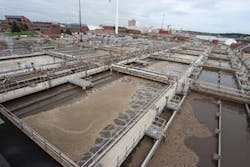The Narragansett Bay Commission owns and operates the Field’s Point Wastewater Treatment Facility (FPWWTF) in Providence, R.I. The commission’s service area encompasses the metropolitan Providence and Blackstone Valley areas. Originally constructed in 1901, the FPWWTF provides secondary treatment for maximum monthly flows of up to 77 mgd and primary treatment and disinfection for an additional 123 mgd of wet-weather flows. Total treatment capacity at the FPWWTF is 200 mgd.
After receiving a National Pollutant Discharge Elimination System operating permit that required the plant to remove total nitrogen (TN) to 5 mg/L from May to October, the commission chose AnoxKaldnes Hybas (hybrid biofilm activated sludge), an integrated fixed-film activated sludge (IFAS) process, as its solution.
Solution
In 2008, Veolia completed AnoxKaldnes Hybas designs for the upgrade of the FPWWTF to meet new seasonal effluent limits for TN and TIN. The process has the advantage of accepting a significant combined sewer overflow (CSO) while maintaining a nitrifying biomass and eliminating the need to construct new aeration basins on a constrained site.
The IFAS conversion was accomplished without the need to add secondary clarifier capacity. FPWWTF began operation as the largest IFAS system in the world.
Process Description
The FPWWTF project involved process design, equipment supply, training, in-field services, performance testing and guarantees related to the AnoxKaldnes Hybas process. The biological nutrient removal process includes the following unit processes:
- A pre-anoxic stage with two reactors per train for denitrification using the influent biological oxygen demand (BOD) as a carbon source and return mixed liquor from the aerobic stage for the source of nitrate.
- An aerobic nitrification stage with IFAS and post-IFAS oxic zones for BOD and Nitrification.
- A post-anoxic stage with two reactors per train for additional denitrification using an external carbon source (if needed).
- A re-aeration stage for removal of any residual carbon source and nitrogen gas stripping.



